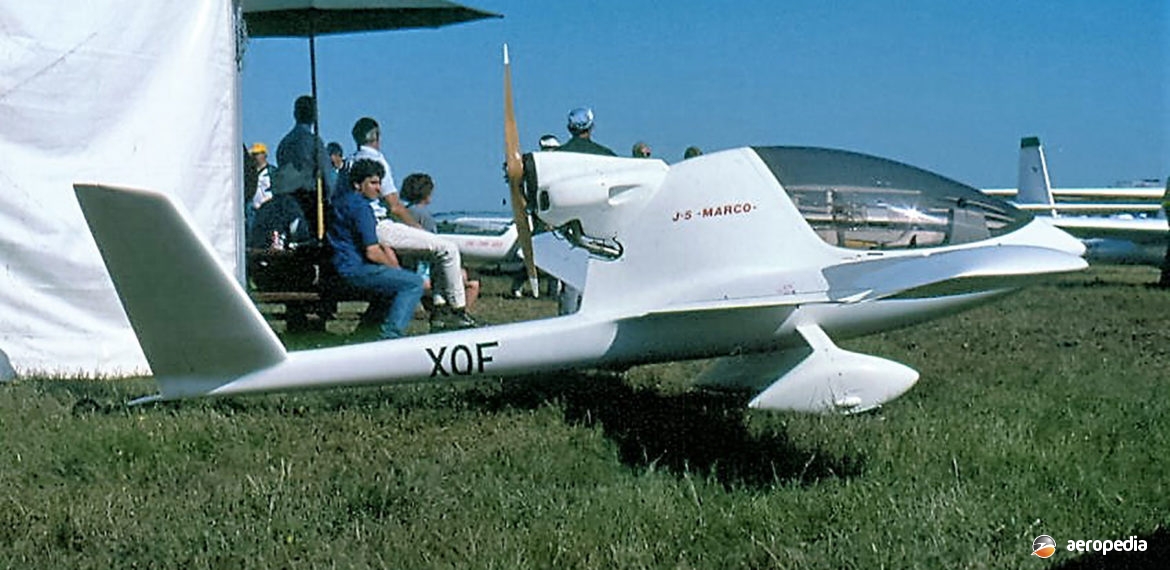Photograph:
Alpha Marco J-5 VH-XQF (c/n A1) at Avalon, VIC in October 1992 (David C Eyre)
Country of origin:
Poland
Description:
Single-seat light sport aircraft
Power Plant:
One 19 kw (25 hp) KFM 107er two-cylinder horizontally-opposed air-cooled engine
Specifications:
- Wingspan: 8.16 m (26 ft 9¼ in)
- Length: 4.66 m (15 ft 3½ in)
- Height: 1.4 m (4 ft 7¼ in)
- Wing area: 6.3 m² (67.5 sq ft)
- Cruising speed: 169 km/h (105 mph)
- Economical cruising speed: 150 km/h (93 mph)
- Stalling speed: 78 km/h (48 mph)
- Max rate of climb at sea level: 182 m/min (600 ft/min)
- Service ceiling: 3,050 m (10,000 ft)
- Range with max fuel: (25 litres/5.5 Imp gals) 547 km (340 miles)
- Empty weight: 165 kg (363 lb)
- Loaded weight: 290 kg (640 lb)
History:
The Alpha Marco J-5, sometimes described as a self-launched glider, was flown for the first time in Poland on 30 October 1983, being designed by Jaroslaw Janowski and built by a branch of the Marko-Electronic Company in Lodz, Poland, a factory being set up to build kits. This company was established to construct and export light aircraft kits for amateur construction. Later the company became known as Alpha, and Alpha/USA Aviation Inc was set-up in Illinois in the United States to distribute kits. The company also produced a number of microlight types. Agencies were set up overseas to market the aircraft, a company known as Hewa-Technics producing both kits and complete aircraft in Germany. A company, Aviation Farm Ltd, was set up in Poland and built the aircraft under licence.
Mr Janowski had previously designed other homebuilt ultralight gliders and they were known as the J-1, J-2 and J-3. Like the J-5, they were pod-and-boom aircraft with a pusher engine. Engine usually fitted was the KFM 107ER unit but a few had the 31 kw (45 hp) Rotax 447UL two-cylinder, in-line, two stroke unit or the Hirth F-23 engine. The aircraft had a side-stick control column and the instruments were mounted on a vertical panel in front of the pilot. It could be fitted with a retractable monowheel undercarriage with stabilising wheels mounted on the wingtip extensions; or a pair of fixed cantilever-mounted wheels attached to the fuselage.
One example (F-WZUE) set several FAI Class-C-1a/O records in 1990-1991. There were a number of variants including the J-5BAL which carried a thermal imaging camera and was for military use; the J-5bis which was fitted with a 48 kw (65 hp) Walter M202 engine; and the BAE Herti-D which was used as the basis of an unmanned aerial vehicle, it having a small turbojet in lieu of a piston engine.
Built basically of fibreglass and epoxy, only the flaperons were constructed of fibreglass and aluminium. The aircraft was supplied in kit form and could be fitted with a fixed or retractable undercarriage. The latter comprised a retractable mainwheel and non-retractable tail-wheel with wingtip balancers. G limits were +6/-3.
First of the type registered in this region was VH-XQF (c/n A1) on 29 July 1991. It was withdrawn from use in 2001 but re-registered in 2004. In October 2008 the registration was allotted to a Jabiru aircraft, so the Marco was removed from the Civil Aircraft Register again.

